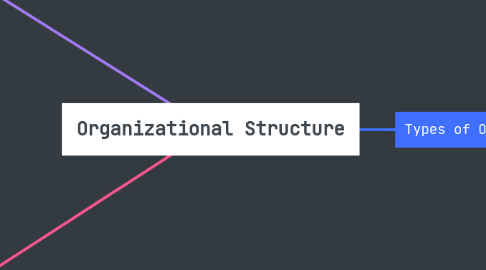
1. Mechanistic vs. Organic Organizational Structures
1.1. Mechanistic Structure (bureaucratic structure)
1.1.1. narrow spans of control
1.1.2. high centralization
1.1.3. high specialization
1.1.4. high formalization
1.2. Organic Structure (flat)
1.2.1. wide spans of control
1.2.2. decentralization
1.2.3. low specialization
1.2.4. loose departmentalization
2. Types of Organizational Structure
2.1. 1. Functional Organizational Structure
2.1.1. Disadvantages
2.1.1.1. barriers between different functions
2.1.2. Advantages
2.1.2.1. increases efficiency
2.1.2.2. provides stability
2.1.2.3. boosts accountability
2.2. 2. Product-Based Divisional Structure
2.2.1. Disadvantages
2.2.1.1. duplicating resources
2.2.2. Advantages
2.2.2.1. separation
2.2.2.2. mitigate risk
2.3. 3. Market-Based Divisional Structure
2.3.1. Disadvantages
2.3.1.1. too much autonomy
2.3.1.2. duplicating resources
2.3.2. Advantages
2.3.2.1. work independently
2.3.2.2. focus on the needs
2.4. 4. Geographical Divisional Structure
2.4.1. Disadvantages
2.4.1.1. easy for decision- making to become decentralized
2.4.2. Advantages
2.4.2.1. catering to a specific customer
2.5. 5. Process-Based Structure
2.5.1. Disadvantages
2.5.1.1. barriers between the different process groups
2.5.2. Advantages
2.5.2.1. increases efficiency and speed
2.6. 7. Circular Structure
2.6.1. Disadvantages
2.6.1.1. confusing, especially for new employees
2.6.2. Advantages
2.6.2.1. information flowing freely across the business
2.7. 6. Matrix Structure
2.7.1. Disadvantages
2.7.1.1. Complexity
2.7.2. Advantages
2.7.2.1. promotes collaboration and communication
